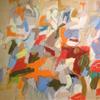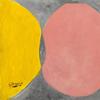William T. Williams: Recent Paintings
- NEW YORK, New York
- /
- August 13, 2019

Michael Rosenfeld Gallery is pleased to present its fourth solo exhibition for William T. Williams (American, b. 1942), showcasing a new body of paintings. Scheduled to be on view from September 6 to November 9, 2019, William T. Williams: Recent Paintings will feature 35 paintings from the 465 Series, the first series of paintings completed by Williams in his rural Connecticut studio. A masterful colorist, his new work continues to expand our understanding of abstraction and positions Williams as one of the great abstractionists of his generation.
William T. Williams: Recent Paintings will be accompanied by a fully-illustrated color catalogue with new scholarship by Jonathan P. Binstock, Mary W. and Donald R. Clark Director of the Memorial Art Gallery (MAG), Rochester, NY and an interview conducted by Hans Ulrich Obrist, Artistic Director at Serpentine Galleries, London.
The work of William T. Williams resonates with cultural history and personal memories of a childhood spent in the urban environments of New York as well as the southern landscapes of rural North Carolina, where he was born. Returning to country life, the artist’s recent relocation of his studio from New York City to the natural environment of Connecticut embodies a renewed vision toward painting. There, he has reinvented his studio practice in a soaring, light-filled, renovated barn, replete with large windows that overlook an ever-changing landscape. William T. Williams: Recent Paintings will be the first exhibition of the new body of work produced under the natural light and rhythms of Williams’ new studio. This environment, immersed in nature, has had a profound effect on the artist’s recent work, whose richly-hued abstractions reflect the shifting dynamics of seasonal and atmospheric change.
The dynamism of these natural ebbs and flows permeates Williams’ paintings, creating discernible shifts felt palpably through composition and color. The complex palettes of this life-long colorist will be showcased, from the vibrant and bold to the muted and somber. Working at a smaller, more intimate scale than ever before, Williams has experimented with the combination of multiple canvases. The seriality of the paintings offers a meditative form of time-keeping, a cyclical repetition that structures and documents his daily routine in the studio. Their multi-color grid compositions of layered paint recall the quilts that were prominent in the Williams’ household. This modular approach of “patch-working” individual panels together employs varying configurations of contrasting forms and colors to generate dialogues within each work.
The work of William T. Williams is deeply influenced and inspired by jazz, and the artist has referred to his method of working through distinct series as that of a “theme and variations.” On the occasion of William T. Williams: Recent Paintings, the artist has developed a jazz playlist of 30 favorites. The playlist includes iconic tracks that are in frequent rotation in the artist’s studio by jazz legends such as John Coltrane and Miles Davis and contemporary musicians and composers like Jason Moran, Ron Carter, Karen Patterson and Wynton Marsalis. Williams observed recently, “I start out every day with Coleman Hawkins, because that brings me back to a specific time, and there’s a tone that he has in his music that I really love… When I’m working, I listen to different musicians for different things... Each musician brings different nuances to the environment which affects my own thinking. Music is a constant in my studio.”
The 465 Series extends on the techniques and formats explored in the 111 ½ Series, which Williams has described as a record of “place as a specific type of poetry.” Similarly bearing reference to the artist’s address, this new series continues the artist’s consistent exploration of tactility, gesture, color and mark-making. The paintings’ titles include personal and autobiographical references that reflect on a composite of experiences and memories from throughout his life. Together, they illuminate how abstraction became the mode through which Williams felt free to explore both representational and symbolic imagery in his work.
About William T. Williams
The work of William T. Williams (b. 1942) ranges in style from his early geometric abstractions, to almost-monochromatic explorations of texture, to an abstraction that derives its force from productive tension among colors and forms. While he has consistently tested the limits of his earlier styles and developed new approaches, his meticulous attention to the process of art making has remained constant. A master of brushwork and color, Williams creates his paintings in series, working through a labor-intensive process that often includes drawings, watercolors and prints.
From the outset of his career, Williams’ art was characterized by bold color and daring compositions that paid homage to and challenged the abstraction that had come before it. He emerged at a time when abstract expressionism was in decline, while pop art, color field painting, and minimalism were on the rise. Concurrent with this aesthetic transition were social and political transformations that saw artists, intellectuals, and activists challenging the exclusionary practices of New York’s white- and male-dominated art institutions. These critiques came in multiple forms, including an approach to art that favored figural representation embedded in a politics of struggle and an assertion of identities misrepresented by or excluded from American culture. Such images were a necessary correction to a history of omission and caricature, but they risked being received by the art establishment in a way that affirmed its tendency to ignore work by abstract artists who were also African American.
Living in an artist loft building on Broadway that over the years included neighbors Kenneth Noland, Joel Shapiro, Janet Fish, and William Copley, Williams believed that abstraction offered him greater creative and expressive freedom than figural representation, but he was also wary of the potential cold, impersonal aspect of painting that was merely about painting. Williams thus developed an approach that rendered the abstract representational, not only through titles replete with autobiographical references, but also in the shapes he incorporates. Jazz became an important site of convergence where memory, history, and a black American abstract tradition met, and quilting was for Williams another manifestation of an African American tradition of abstraction. His artwork often incorporates the diamond shape as a visual motif that functioned “as a stabilizing force, a form that interacts compositionally with what's around it. But it goes back to the quilts of my childhood, the patterns and forms I grew up with.”
The synthesis between personal/cultural narrative and abstraction that Williams developed early on in his career was met with deserved success. Born in rural North Carolina, Williams moved to New York with his family as a youth. He attended the School of Industrial Art (now the High School of Art and Design) and received an associate degree at New York Community College, before enrolling at Pratt Institute in 1962. At Pratt, he studied with some of the foremost figurative painters of the day including Richard Lindner, Philip Pearlstein and Alex Katz, but it was painter Richard Bove who encouraged Williams to work from intuition and memory rather than from observation. The resulting abstract work found support amongst his professors whose encouragement led Williams to pursue graduate studies at Yale University. The graduate department at Yale provided a rigorous theoretical foundation and studio practice for the artist as the faculty included George Wardlaw, Jack Tworkov, Al Held, Lester Johnson, and others.
Williams completed his MFA at Yale in 1968 and moved to New York. In 1969, the Museum of Modern Art (MoMA) purchased his Elbert Jackson, L.A.M.F. Part II (1969). That same year, he was included in the Whitney Biennial and he organized X to the Fourth Power at the newly opened Studio Museum in Harlem. In 1968, Williams formed the muralist collective Smokehouse Associates along with Mel Edwards, Guy Ciarcia, and Billy Rose; they were active in Harlem from 1968 to 1970. Williams conceptualized the artist-in-residence program at The Studio Museum, which remains to this day a core mission objective and functions in its original iteration according to the guidelines that Williams instituted. In 1971, Reese Palley Gallery, New York mounted Williams’ first solo exhibition and he began teaching at Brooklyn College of the City University of New York (CUNY), where he was on faculty for four decades, inspiring hundreds of students including Nari Ward and Arthur Simms. In 1965, he spent a summer in Maine as a student at the Skowhegan School of Painting and Sculpture, returning as faculty in 1971, 1974, 1978, and 1979; the latter year he served as Director Pro Tem. In 1975, Bob Blackburn invited Williams to make a print at the Printmaking Workshop; over the next 22 years, Williams collaborated with Blackburn to produce 19 editions, as well as a number of unique print projects. In keeping with this ongoing interest in printmaking, Williams has also collaborated on prints with the Brandywine Workshop and Lafayette College’s Experimental Printmaking Institute (EPI). In 1977, he participated in the Second World Festival of Black Art and African Culture (Festac '77), held in Lagos, Nigeria, which marked his first time in Africa. The trip, especially the movements of patterned clothing he saw on the street, had a profound effect on his art, and Williams began a series of paintings inspired by this African tradition of abstraction. Williams has continued to revise, adapt, and transform his style, and this dynamism combined with a consistent set of formal and thematic concerns has contributed to the longevity of his luminous career.
Williams has been the recipient of numerous awards and fellowships, including: the Individual Artist Award in Painting from the National Endowment for the Arts (1970), a John Simon Guggenheim Fellowship (1986), The Studio Museum in Harlem Artist’s Award (1992), a National Endowment for the Arts Regional Fellowship (1994), a Joan Mitchell Foundation Grant (1996), the Brandywine Workshop’s James Van Der Zee Award for lifetime achievement in the arts (2005), the North Carolina Governors Award for the Fine Arts (2006), the Alain Locke International Award from the Detroit Institute of Arts (2011), and the Skowhegan Governors Award for Outstanding Service to Artists from the Skowhegan School of Painting & Sculpture (2017). Recently, Williams was inducted into the newest class of National Academician members at the National Academy Museum & School in New York (2017) and he is the recipient of the 2018 Pratt Institute Legends Award and the 2019 Lifetime Achievement Award at the 30th Annual James A. Porter Colloquium, Howard University, Washington, DC. Williams was also the first African American contemporary artist to have his work (Batman, 1979) included in The History of Art by H.W. Janson.
For over forty years, Williams’ work has consistently been shown at home and abroad. Representation in groundbreaking exhibitions includes L'Art Vivant Aux Etats-Unis (Fondation Maeght, Saint-Paul-de-Vence, France, 1970); The Structure of Color (Whitney Museum of American Art, 1971); To Conserve a Legacy: American Art from Historically Black Colleges and Universities (Addison Gallery of American Art, 1999); What is Painting? (MoMA, 2007); Blues for Smoke (Museum of Contemporary Art, LA, 2012) and Witness: Art and Civil Rights in The Sixties (Brooklyn Museum, 2014). In 2016, he was featured in the inaugural exhibition at the Smithsonian Institution’s National Museum of African American Art and Culture (Washington, DC) and in 2017, his contributions as part of the mural collective Smokehouse Associates were examined in Smokehouse, 1968-1970 at The Studio Museum in Harlem.
Recent solo presentations of the artist’s work include William T. Williams: Theme and Variations at the Morris R. Williams Center for the Arts, Lafayette College in Easton, PA (2009) and William T. Williams: Variations on Themes at The David C. Driskell Center for the Study of the Visual Arts and Culture of African Americans and the African Diaspora, University of Maryland in College Park (2010). In 2017, Michael Rosenfeld Gallery presented its first solo exhibition for Williams, William T. Williams: Things Unknown, Paintings, 1968-2017, which celebrated five decades of work and featured an overview of the artist’s most major painting series. The exhibition was accompanied by a fully-illustrated catalogue with engaging conversations between the artist and Thelma Golden, Director and Chief Curator of The Studio Museum in Harlem, and Courtney J. Martin, Deputy Director and Chief Curator at Dia Art Foundation. At Frieze New York this year, Michael Rosenfeld Gallery presented William T. Williams: 1970, an exhibition that focused on the pivotal year 1970 and highlighted a selection of seminal paintings and never-before-exhibited works on paper from the artist’s first mature series, Diamond in a Box.
Williams is represented in over thirty public collections, including the Detroit Institute of the Art (MI); Fogg Museum (Harvard Art Museums, Cambridge, MA); The Menil Collection (Houston, TX); The Museum of Modern Art (New York, NY); Nelson A. Rockefeller Empire State Collection (Albany, NY); North Carolina Museum of Art (Raleigh); Philadelphia Museum of Art (PA); Sheldon Museum of Art, University of Nebraska (Lincoln); The Studio Museum in Harlem (New York, NY); Whitney Museum of American Art (New York, NY); and Yale University Art Gallery, Yale University (New Haven, CT).
More information on William T. Williams (b. 1942)
The work of William T. Williams can be seen in the following current and upcoming museum exhibitions:
Soul of a Nation: Art in the Age of Black Power, The Broad, Los Angeles, CA, March 23–September 1, 2019; de Young Museum, Fine Arts Museums of San Francisco, San Francisco, CA, November 9, 2019–March 15, 2020
Black Refractions: Highlights from The Studio Museum in Harlem, Kalamazoo Institute of Arts, Kalamazoo, MI, September 13–December 8, 2019
The Shape of Abstraction: Selections from the Ollie Collection, Saint Louis Art Museum, St. Louis, MO, September 17, 2019–March 8, 2020
Generations: A History of Black Abstract Art, The Baltimore Museum of Art, Baltimore, MD, September 29, 2019–January 19, 2020
With Pleasure: Pattern and Decoration in American Art, 1972-1985, The Museum of Contemporary Art, Los Angeles, CA, October 27, 2019–May 11, 2020
Michael Rosenfeld Gallery
Since 2016, Michael Rosenfeld Gallery has been the exclusive representative of William T. Williams. Michael Rosenfeld Gallery specializes in 20/21 century art. Established in 1989 by Michael Rosenfeld, the gallery opened its doors to promote the breadth of American art and those artists—known or unknown—that contributed to the establishment of surrealism, social realism, abstract expressionism, figurative expressionism and geometric abstraction. Michael Rosenfeld Gallery is located at 100 Eleventh Avenue, New York, NY, 10011. Gallery hours are Tuesday through Saturday, 10:00AM–6:00PM.
Press Inquiries
Dan Munn, Communications Associate
dm@michaelrosenfeldart.com, 212.247.0082
Contact:
Dan MunnMichael Rosenfeld Gallery
2122470082
dm@michaelrosenfeldart.com
100 Eleventh Ave
New York, New York
info@michaelrosenfeldart.com
212-247-0082
http://www.michaelrosenfeldart.com/
















